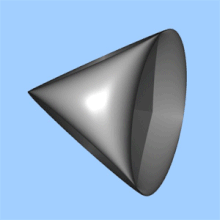Our website is made possible by displaying online advertisements to our visitors.
Please consider supporting us by disabling your ad blocker.
Roman surface
This article is written like a research paper or scientific journal. (March 2018) |
This article includes a list of general references, but it lacks sufficient corresponding inline citations. (March 2018) |

In mathematics, the Roman surface or Steiner surface is a self-intersecting mapping of the real projective plane into three-dimensional space, with an unusually high degree of symmetry. This mapping is not an immersion of the projective plane; however, the figure resulting from removing six singular points is one. Its name arises because it was discovered by Jakob Steiner when he was in Rome in 1844.[1]
The simplest construction is as the image of a sphere centered at the origin under the map This gives an implicit formula of
Also, taking a parametrization of the sphere in terms of longitude (θ) and latitude (φ), gives parametric equations for the Roman surface as follows:
The origin is a triple point, and each of the xy-, yz-, and xz-planes are tangential to the surface there. The other places of self-intersection are double points, defining segments along each coordinate axis which terminate in six pinch points. The entire surface has tetrahedral symmetry. It is a particular type (called type 1) of Steiner surface, that is, a 3-dimensional linear projection of the Veronese surface.
- ^ Coffman, Adam. "Steiner Roman Surfaces". National Curve Bank. Indiana University - Purdue University Fort Wayne.
Previous Page Next Page







